The Port of Tacoma is a publicly owned and managed port district established by Pierce County voters in 1918. Today it is a leading container port, serving as a "Pacific Gateway" for trade between Asia and the central and eastern United States as well as the Northwest. Most of the maritime commerce between Alaska and the lower 48 states also passes through Tacoma. A suite of factors that the Port calls the "Tacoma Advantage" have contributed to its success. The advantages begin with the port's location on the Tacoma tideflats along the deep waters of Commencement Bay. The Port's acreage has allowed it to create efficient intermodal transportation connections between ship and road or rail, often right on the dock. Cooperation between Port management and union longshore workers has provided an additional advantage, helping bring many of the world's largest container lines to Tacoma. This slideshow was written and curated by Kit Oldham and sponsored by the Port of Tacoma.
Port of Tacoma -- A Slideshow
- By Kit Oldham
- Posted 8/26/2008
- HistoryLink.org Essay 8743
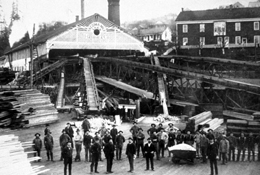
From its beginnings, Tacoma has been a trading port. The first non-Indian settler on Commencement Bay, Nicholas Delin, built a sawmill from which he shipped timber to San Francisco. In 1868, Charles Hanson, a Danish sea captain turned California mill owner, constructed a larger sawmill and wharf. Tacoma's international trade began in 1871, when the Hanson & Company mill shipped lumber to Peru on five French ships.
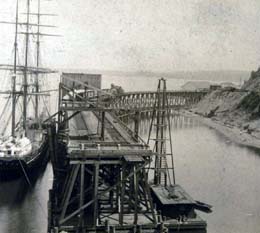
Tacoma first linked rail to water transport in 1873, when the Northern Pacific Railroad chose Commencement Bay as its Western terminus. The railroad bought the Hanson & Company mill along with several miles of waterfront and hundreds of acres of tideflats. The first train reached Commencement Bay in December 1873.
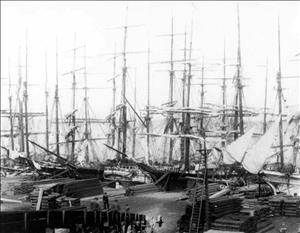
Boosted by the railroad and expanding trade, Tacoma boomed during the 1880s. The population rose from barely 1,000 inhabitants in 1880 to more than 36,000 a decade later, much of the growth coming after the Northern Pacific completed its transcontinental line to Tacoma in 1887. Imports of all kinds, including tea from Japan, crossed the docks that expanded over the Tacoma tideflats, as did even larger volumes of exports, led by lumber, coal, and wheat.

Longshore workers who loaded and unloaded the ships docked in Commencement Bay sought their share of the increasing prosperity. The first unions in Washington Territory formed during the early 1880s. Tacoma dock workers were among the organizers of the Knights of Labor, which agitated for higher wages and shorter hours -- and also against the presence of Chinese workers. On March 22, 1886, Tacoma longshore workers went on strike, demanding that the DeLion Stevedoring Company, which controlled the dock work, increase wages from 30 to 40 cents an hour and hire only union members. The company acceded four days later. The newly organized Stevedores, Longshoremen and Riggers Union of Puget Sound was the first longshore local in Washington (Seattle dockworkers organized their first local a few months later in June 1886).
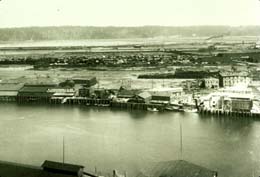
The boom years of the 1880s did not last. The Panic of 1893 brought hard times nationwide. Another nationwide depression hit in 1907. In response to the troubled economic times and the increasing concentration of wealth and resources in the hands of corporate monopolies, progressive reformers, including many longshore workers, had been arguing since the 1890s for greater public control over ports and waterfront areas. The state legislature responded in 1911 by authorizing the creation of publicly owned port districts to manage harbors and waterfront facilities. Longshore workers and Tacoma businessmen promoted a 1912 ballot measure to create a public Port of Tacoma, but the proposal was narrowly defeated, in part because rural Pierce County voters felt the port would benefit the city only.
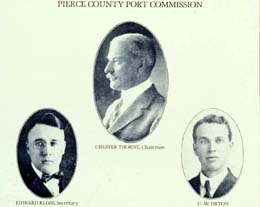
Public port proponents tried again in 1918. They made a concerted effort to woo rural voters, in part by promising a cold-storage facility on the docks that would allow Puyallup Valley farmers to ship their crops without losing large amounts due to improper storage. This time Pierce County voters agreed, creating the Port of Tacoma and electing banker Chester Thorne, longshore official Edward Kloss, and Sumner farmer Charles W. Orton to the port commission that would run the port.
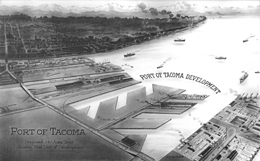
The commissioners hired Frank J. Walsh to create a plan for development of the port. In May 1919, voters approved Walsh's master plan for the Port of Tacoma and a $2.5 million bond issue to fund land purchase and construction of the first two piers Walsh proposed. Plans for the 800-foot-long, 160-foot-wide Pier 1 were ready by the end of the year and construction began on March 25, 1920.

Exactly one year to the day after construction began on Pier 1, the Pacific Coast Steamship Company's Edmore became the first ship to call at the Port of Tacoma. Workers from International Longshoremen's Association Locals 38-3 and 38-30 loaded 600,000 board feet of lumber onboard in a record-setting 24 hours, and on March 26, 1921, the fully loaded Edmore sailed for Yokohama, Japan. Shipping business grew so rapidly that even before the 1923 completion of Pier 2, which featured a huge bulk-storage transit shed and a unique overhead monorail crane system, the commissioners were planning to extend Pier 1 to provide more room for docking ships.
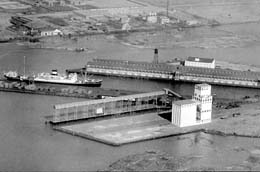
As port business grew during the 1920s, the Port worked to develop the cold-storage facility that had been promised to Puyallup Valley farmers, but it was 1931 before the plant was completed. Meanwhile the commissioners were also planning a publicly owned grain elevator to handle crops from farther afield. In November 1928 voters approved a $500,000 bond issue to fund the grain elevator. The United Grain Terminal, with a capacity of 450,000 bushels and a 600-foot-long, railroad-tracked pier, opened in August 1930, enabling the Port of Tacoma to export grain from Eastern Washington and Oregon and as far away as the Midwest.
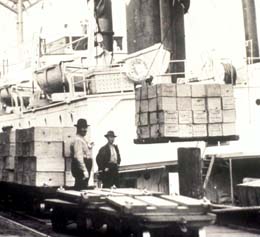
The Great Depression began in 1929, even before the grain elevator and cold-storage facility were complete. Shipping tonnage, wages, and jobs all fell precipitously. President Franklin Roosevelt's New Deal improved conditions somewhat and shipping began to pick up in the mid-1930s. New Deal reforms gave unions more clout than they previously had. In 1934, when employers rejected collective bargaining, the International Longshoremen's Association, joined by other shipping-industry workers, closed every major port on the West Coast during an 85-day strike. Federal arbitration settled the strike in favor of the longshore workers.
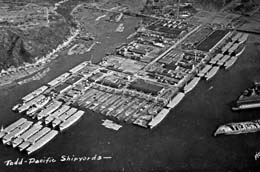
Once the United States entered World War II, the Tacoma waterfront was largely given over to the military effort from 1942 until 1945. Troops trained at Fort Lewis were dispatched to the Pacific theater from Port of Tacoma piers. Food, supplies, and munitions for the armed forces also moved across the increasingly mechanized docks. The United States military spent freely on new equipment to speed up loading and discharging. Forklifts replaced jitneys for moving cargo from warehouses to docks and the military also introduced the first small containers, known as Conex boxes, foreshadowing the container revolution of future decades. Todd Pacific Shipyard, which employed more than 30,000 workers at its peak, launched 74 ships from the Tacoma tideflats during the war years.
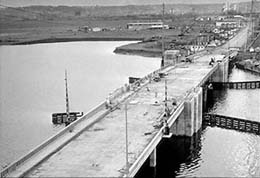
In 1946, following the end of World War II, maritime trade fell by 90 percent to well below the pre-war levels of 1940. Port of Tacoma commissioners responded to the economic downturn with renewed efforts to attract manufacturers to the Port Industrial District established just before the United States entered the war. Beginning in the early 1950s, the Port embarked on further improvements, dredging the Industrial Waterway (later named Blair Waterway) to accomodate larger ships. The Industrial Waterway Bridge opened in 1953 to provide a direct connection from downtown to the eastern tideflats and the Northeast Tacoma neighborhood. Its drawbridge opened to a width of 150 feet, sufficient for the largest freighters of the era.
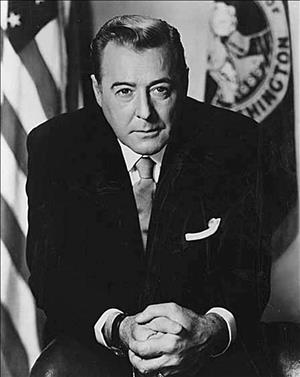
During the 1950s, port commissioners won the support of Democratic Senator Warren G. Magnuson and Republican Representative Thor C. Tollefson in their pursuit of federal funds for port development. When their initial efforts did not succeed, the commisioners decided that a detailed development plan for the port would help secure federal funding. The Tibbetts-Abbett-McCarthy-Stratton (TAMS) engineering firm prepared a plan that guided port development for many years. The commissioners won voter approval of a $5.4 million bond issue to fund the first stage of the development, extending the Hylebos Waterway located on the eastern edge of the tideflats.

In 1964, after a nationwide search for an executive director, the Port hired Ernest L. "Roy" Perry, who had recently retired from the Army Corps of Engineers office in Seattle. Perry completed the expansion of the Blair and Hylebos Waterways called for in the TAMS plan and brought the Port of Tacoma into the modern container era. Under his leadership, the Port built new warehouses and piers for container cargo at Terminal 4 near the mouth of Blair Waterway and at Terminal 7 on the shorter Sitcum Waterway.

During the 1960s, the Kaiser Aluminum Corporation greatly expanded its aluminum plant located on the east side of Blair Waterway. The plant first produced aluminum during World War II and was acquired by Kaiser, as the company's first wholly owned aluminum plant, in 1947. A massive smelter with a 500-foot-tall smokestack was completed in 1968. A few miles away at Terminal 7, two prominent alumina domes -- sometimes termed the "original Tacoma domes" (the actual Tacoma Dome arena opened in 1983) -- were built to store ore for use at the smelter.
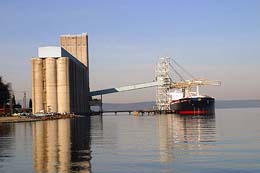
The Port of Tacoma entered the container era in 1970 when it acquired its first container crane to lift the 20-foot boxes in which all but the most bulky or unwieldy cargo was now transported. Even as the Port increased its container capacity through the 1970s, it also continued to expand the ability to handle bulk exports like forest products and grain. Blair Terminal, with two berths for log exports, opened in 1972, followed a year later by Weyerhaeuser's 25-acre wood-chip facility. In 1975, the Port opened the Continental Grain Terminal on Ruston Way north of downtown Tacoma. The new terminal, leased and operated by Cargill, had a capacity of three million bushels, far greater than the original United Grain Terminal, which closed in 1985 and was demolished in 1987 to make room for expansion of the Port's North Intermodal Rail Yard.

While expanding its international trade, the Port of Tacoma also boosted its domestic trade during the 1970s, when it became the "New Gateway to Alaska." Port management teamed with International Longshoremen's and Warehousemen's Union (ILWU) Local 23 to to convince Totem Ocean Trailer Express (TOTE), a leading shipper to Alaska, to move its operations from Seattle to Tacoma. TOTE's first ship began calling at Terminal 7 in 1976 and the company added a second vessel in 1977.
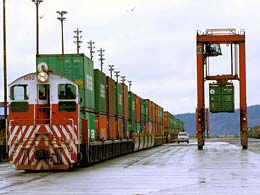
The Port of Tacoma helped pioneer a new phase in trade and transportation history in 1981 when it opened the first dockside railyard on the West Coast. Plans for intermodal connections between ships, railroads, and trucks had been proposed as long ago as the 1960s. Those plans came to fruition with the North Intermodal Yard, located on the main port peninsula between the docks of Terminal 7 on Sitcum Waterway and Terminal 4 on Blair Waterway.
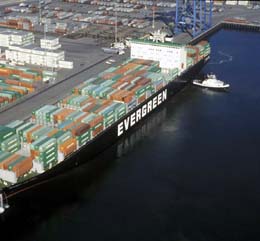
The port's yearly container volume topped one million for the first time in 1991, aided in part by the decision of another major container shipper, Taiwan's Evergreen Line, to move its Northwest terminal from Seattle to Tacoma. The Ever Lyric, the first Evergreen vessel to call at Tacoma, arrived in July 1991.
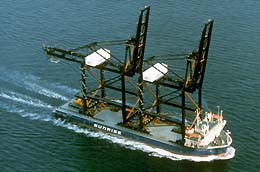
In 1985, two major container shipping lines began operations at the Port of Tacoma. Sea-Land cited the productivity of Tacoma longshore workers and the port's new dockside railyard in announcing its move from Seattle to Tacoma. Construction of the new Sea-Land Terminal was highlighted by the arrival of two new Hitachi container cranes that were shipped fully assembled from Japan, the largest cargo to cross the Pacific Ocean to that point. Not long after, the Endurance became the first Sea-Land ship to call at Tacoma. It was followed by the Charlotte Maersk, the first from the Danish line Maersk. Maersk would later acquire Sea-Land to form Maersk Sealand, which continues to handle a significant portion of the two million containers now shipped annually through the Port of Tacoma.

By the 1980s, the Blair Bridge had become a bottleneck for both maritime and automobile traffic. The 150-foot opening of the drawbridge spanning the Blair Waterway was barely large enough for the container ships then in use. Collisions were frequent, often closing the bridge, an essential link between Northeast Tacoma and downtown, for weeks or months at a time. And with even bigger cargo ships being developed, the narrow opening stymied the Port's plans to expand Blair Waterway to accomodate the next generation of vessels. Residents dependent on the Blair Bridge convinced the Port not to remove the bridge until an alternative route was in place. One day after the opening of a replacement route -- SR 509 looping south of Blair Waterway and reaching downtown Tacoma via a new cable-stayed bridge over the Thea Foss Waterway -- demolition of the Blair Bridge began.

With the Blair Bridge bottleneck gone, the Port commenced work on redeveloping the Blair Waterway. Washington United Terminals (WUT), the first new development on the upper waterway, opened in 1999. WUT became the new home for Korean line Hyundai Merchant Marine, which followed in the footsteps of other container lines by moving its Northwest operations from Seattle to Tacoma. The facility included Hyundai Intermodal Yard with dockside rail connections.

The Port opened the $40 million, 146.5-acre Marshall Avenue Auto Facility in October 2003. Operated by Auto Warehousing Company, which began serving Tacoma in 1970, eight years after its founding in Seattle, the new facility could store and process nearly 20,000 vehicles at a time. Two months later, the Port and Mazda celebrated as the one-millionth Mazda automobile imported through the Port drove off a transport ship at Blair Terminal and made its way to the Marshall Avenue Facility. Within a year, a dedicated bridge over Port of Tacoma Road made the short trip from transport ship to Auto Facility even faster.

On September 9, 2004, four of the world's largest container cranes made a dramatic entrance into Commencement Bay. The fully assembled cranes, each weighing 1,600 tons and standing 249 feet tall with a 209-foot boom, arrived on the deck of a ship designed specifically to transport them across the Pacific from China, where they were manufactured by Zhenhua Port Machinery Co., Ltd. The four cranes, and a fifth shipped later, were purchased by Evergreen Marine Corporation for use at the new Pierce County Terminal at the head of Blair Waterway, which opened in early 2005.
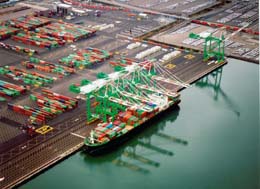
The Port of Tacoma opened three new terminals in 2005, allowing it to handle more than two million containers in a year for the first time. The 171-acre, $210 million Pierce County Terminal and Intermodal Yard, which opened in January as the new Tacoma home of Evergreen Marine Corporation, was the largest construction project in Port history. As soon as Evergreen vacated its former location at Terminal 4, the Port began redeveloping and expanding Husky Terminal on the site. Opened in July, the new Husky Terminal doubled the presence of K Lines at Tacoma. Then in October the Port completed the Olympic Container Terminal, an expansion of K Lines' prior home at Terminal 7, for Yang Ming Line, which became the latest shipper to do business at the Port.
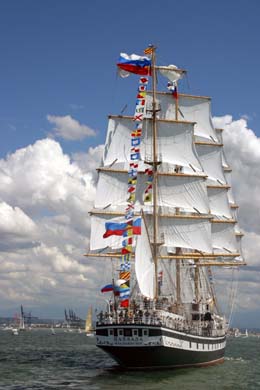
Although growth in trade has slowed in the past few years, the Port of Tacoma continues to plan for future expansion to serve the people of Pierce County and exporters and importers around the state, nation, and world. The Port has been acquiring additional acreage along Blair Waterway, including the 96-acre former Kaiser Aluminum property, where work is now underway on a terminal for NYK Line of Japan, the latest shipper to announce a move from Seattle to Tacoma. Even as Tacoma plans the future of its waterfront, it remembers its maritime past. In 2005 and again in 2008, the Tacoma Tall Ships Festival brought dozens of sailing vessels and hundreds of thousands of visitors to the port. The sails filling Commencement Bay and the forests of masts lining the waterways revived memories of a time when the Tacoma waterfront was crowded with tall ships from around the world.

In November 1988, the Port celebrated the 70th anniversary of its creation by Pierce County voters with the opening of its Public Observation Tower at the head of Sitcum Waterway. The four-story, open air structure was "dedicated to the citizens of Pierce County, in recognition of their initial support which led to the official founding of the Port of Tacoma on November 5, 1918, and to their ongoing support which has ensured its continued growth and success." Open all day every day throughout the year, the tower gives members of the public a safe vantage point for close-up observation of activity at the publicly owned port. Tower visitors have panoramic views of terminals and waterways where tugs guide huge cargo ships to dock and towering cranes stack containers high on the ships' decks. Information displays on each level of the tower recount the Port's history and describe the equipment, buildings, ships, cargo, and activity in view.
Licensing: This essay is licensed under a Creative Commons license that encourages reproduction with attribution. Credit should be given to both HistoryLink.org and to the author, and sources must be included with any reproduction. Click the icon for more info. Please note that this Creative Commons license applies to text only, and not to images. For more information regarding individual photos or images, please contact the source noted in the image credit.
